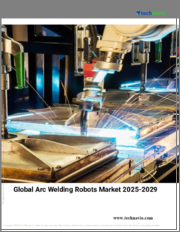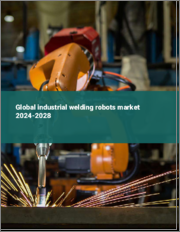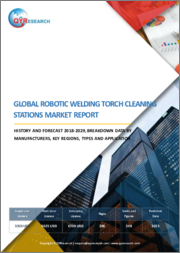
|
시장보고서
상품코드
1681541
용접 토치 및 팁 교환 로봇 스테이션 시장 : 현황 분석 및 예측(2024-2032년)Welding Torch and Tip Changing Robotic Station Market: Current Analysis and Forecast (2024-2032) |
||||||
용접 토치 및 팁 교환 로봇 스테이션 시장은 예측 기간 동안 8.50%의 안정적인 성장률을 기록했습니다. 시장 성장을 촉진하는 주요 요인으로는 여러 최종 사용 산업에서 용접 자동화가 빠르게 채택되고 있다는 점을 들 수 있습니다. 작업 효율의 향상과 함께 인건비가 증가함에 따라 안정적이고 고품질의 용접이 요구됨에 따라 로봇 용접 스테이션에 대한 수요가 급증하고 있습니다. 토치 및 팁 교환을 자동화하는 로봇 용접 스테이션은 다운타임을 줄이고, 안전성을 향상시키며, 초고온-고열 환경에서의 정확도를 높입니다. 이러한 로봇 시스템에 첨단 센서와 인공지능을 통합하면 더 나은 유연성, 성능 및 시장 확대가 가능해집니다. 전 세계가 인더스트리 4.0의 확립과 제조 관행과 관련하여 다양한 산업에서 디지털화의 이점을 더욱 극대화하기 위해 완전히 전환하고 있기 때문에 더 나은 프로세스와 워크플로우 최적화를 위해 이러한 솔루션을 채택할 수 있는 길이 열리고 있습니다. 예를 들어, FANUC America는 2023년 8월에 CRX-25iA 코봇과 CRX-10iA/L 코봇이라는 두 종류의 용접 로봇을 시연했습니다. 이는 FANUC가 CNC(컴퓨터 수치제어), 로봇공학, 그리고 ROBOMACHINE(로보머신) 분야의 선두주자이기 때문입니다. 또한, FANUC의 최신 첨단 로봇 기술에는 iRVision의 고정밀 애플리케이션을 위한 ARC Mate 100iD 로봇과 같은 최첨단 기능이 통합되어 있으며, FANUC에 따르면 자동 도장 루틴은 업계 전체의 모든 스프레이 도장 공정을 위한 로봇을 포함한 기계가 될 것이라고 합니다.
토치 모델을 기반으로 용접 토치 및 팁 교환 로봇 스테이션 시장은 가스 냉각식 및 수냉식으로 세분화됩니다. 2023년에는 가스 냉각식 부문이 시장에서 가장 큰 비중을 차지했으며 향후 예측 기간 동안에도 마찬가지입니다. 비용 효율적이고 사용이 편리하며 유지보수가 용이한 가스 냉각 토치는 다양한 산업, 특히 자동차 및 제조 산업에서 널리 사용되고 있습니다. 가스 냉각 토치는 수냉이 특수하고 운영상의 제약으로 인해 수냉이 어려운 상황에서의 용접에 저비용의 대안을 제공합니다. 로봇 기술의 발전으로 가스 냉각 시스템의 효율성과 정확성은 그 수요를 유지하는 데 큰 도움이 되고 있습니다. 자동화 및 로봇화된 용접 시스템의 출현으로 다운타임을 줄이고 생산성을 향상시키는 가스 냉각 용접 스테이션에 대한 제조업체의 관심이 높아지고 있습니다. 모듈식 및 유연한 로봇 시스템에 대한 수요가 급증하면서 기존 워크플로우에 쉽게 통합할 수 있는 가스냉각 토치가 선호되고 있으며, AI를 활용한 용접 시스템의 발전과 에너지 효율적인 솔루션의 개발로 가스냉각 토치의 미래는 밝습니다.
용접 토치 및 팁 교환 로봇 스테이션 시장은 토치 유형에 따라 아크 용접, MIG 용접, TIG 용접, SMAW, 레이저 용접, 플라즈마 용접으로 구분되며, 2023년에는 MIG 용접 부문이 시장을 장악하고 예측 기간 동안 그 우위를 유지할 것으로 예상됩니다. 이러한 수요 증가는 자동차, 제조, 건설 및 기타 산업에서 널리 사용되는 MIG 용접이 속도, 용이성, 다양한 재료에 강력하고 깨끗한 용접부를 형성하는 능력으로 인해 널리 사용되고 있기 때문입니다. 이러한 특징으로 인해 MIG 용접은 스테인리스 스틸과 알루미늄을 포함한 여러 금속의 조작 능력을 활용할 수 있기 때문에 로봇 시스템에 선호되는 기술입니다. 또한, 그 효율성으로 인해 대량 생산, 특히 설비 내 용접 작업의 요구가 높은 자동차 분야에서 채택이 증가하고 있으며, MIG 용접과 첨단 로봇 공학의 조합은 생산성을 극대화하고 다운타임을 최소화하기 때문에 대량 생산 업무에 적합합니다. 한편, TIG 용접과 레이저 용접은 항공우주 및 의료기기 등 다양한 산업에서 정밀 용접 용도로 사용할 수 있기 때문에 성장 규모를 확대할 수 있는 위치에 있습니다. 이러한 특수한 유형의 용접은 보다 스마트하고 자동화된 용접 솔루션에 대한 추세로 인해 더욱 강화되고 있으며, 대부분 AI와 IoT가 통합된 로봇을 통해 더욱 강화되고 있습니다.
자동화 유형에 따라 용접 토치 및 팁 교환 로봇 스테이션 시장은 반자동화와 완전 자동화로 구분됩니다. 이 중 완전 자동화 부문이 2023년 시장을 독점하고 있으며, 예측 기간 동안 계속 선두를 유지할 것으로 예상됩니다. 일부 산업, 특히 자동차, 항공우주, 중공업의 용접 작업은 정확성, 효율성, 비용에 대한 요구가 높습니다. 완전 자동화 시스템은 최소한의 인력 개입으로 연속적인 고속 생산의 높은 잠재력을 제공합니다. 이러한 완전 자동화 시스템은 반복적인 작업의 특성상 효율적이고 안정적인 구현이 요구되는 대량 생산 공장에 매우 유용하며, AI, 머신러닝, 실시간 모니터링 등 다양한 첨단 기술이 적용되어 중단 없는 작동을 보장하고 각 작업에 필요한 용접 파라미터를 쉽게 조사하고 수정할 수 있습니다. 따라서 자동화를 통해 가동 중지 시간을 크게 단축하고 작업자를 위험한 작업 환경으로부터 멀어지게함으로써 안전성을 향상시키고 인건비를 절감할 수 있습니다.
용접 토치 및 팁 교환 로봇 스테이션 시장은 최종 용도에 따라 일반 엔지니어링, 자동차, 건설, 항공우주, 기타로 분류되며, 2023년에는 자동차 부문이 우위를 점하고 예측 기간 동안 주도권을 유지할 것으로 예상됩니다. 자동차 제조 분야에서는 로봇 용접 스테이션이 제공하는 성장 전망보다 정밀도에 대한 요구가 증가하고 있으며, 로봇 용접 스테이션은 속도와 비용 효율성 측면에서 고품질 대량 생산에 적합한 선택으로 간주되는 경우가 많습니다. 자동차 산업이 비용 절감과 처리량 가속화에 중점을 두면서 토치 및 칩 교체를 위해 로봇 용접 스테이션을 사용하는 것이 점점 더 친숙해지고 있습니다. 로봇 용접은 섀시 조립, 차체 용접, 구조 부품 제조 등의 용도로 자동차 산업에서 필수적인 요소로 자리 잡고 있습니다. 이러한 분야의 자동화는 자동차 생산, 특히 대량 및 고품질 생산에 대한 업계의 높은 요구 사항을 충족하는 데 있어 더 짧은 사이클, 더 적은 인적 오류, 더 높은 정확도를 제공합니다. 용접 토치 및 팁 교환 로봇에 대한 추가적인 원동력은 전기자동차(EV)로의 전환이 진행되고 있으며, EV는 배터리 조립 및 경량 소재의 정밀한 용접 공정이 요구됩니다. 이러한 시스템을 동시에 도입함으로써 자동차 제조업체는 효율적인 생산능력을 추구하게 됩니다. 따라서 운영 비용 절감, 안전 및 환경 기준 관련 규제 준수 등이 일반적인 원칙이 될 것입니다.
용접 토치 및 팁 교환 로봇 스테이션 시장을 더 잘 이해하기 위해 시장은 북미(미국, 캐나다, 기타 북미), 유럽(독일, 영국, 프랑스, 이탈리아, 스페인, 기타 유럽), 아시아태평양(중국, 일본, 인도, 기타 아시아태평양), 기타 세계 지역별로 분석됩니다. 북미가 시장을 지배하고 있으며, 예측 기간 동안에도 지배적일 것으로 예상됩니다. 다양한 상업시설 및 주거용 건물 건설에 대한 투자가 빠르게 증가하고 있는 것이 시장 성장의 주요 요인으로 작용하고 있습니다. 북미 지역, 특히 미국에는 자동차, 항공우주, 일반 엔지니어링과 같은 주요 벌크 제조 산업과 광범위한 제조 산업이 있어 이러한 기계의 주요 사용자로 자리 잡고 있습니다. 이 지역은 기술 혁신과 첨단 제조 기술을 매우 중요시하여 생산 라인에서 로봇 공학의 높은 수준의 통합을 유발하는 유리한 조건을 조성하고 있으며, Lincoln Electric과 FANUC America는 용접 및 자동화를 위한 첨단 로봇 시스템 개발의 선두주자입니다. 북미의 주요 OEM 및 Tier 1 공급업체들은 로봇 용접 기술을 가장 먼저 채택한 기업으로 간주됩니다. 자동 용접 기술은 일관성과 확장성을 보장하기 위해 이들 OEM이 바디 인 화이트 조립부터 여러 공정에서 사용할 수 있습니다. 또한 미국은 성숙한 시장 중 하나이며, 발전용 태양광 패널과 풍력발전용 풍차가 설치되고 미국 정부의 다양한 지속가능한 에너지 구상이 추진되고 있습니다. 이러한 구조물의 설치 및 설치, 유지보수를 위해서는 높은 곳에서의 용접 토치가 필요하며, 첨단 팁 교환 로봇 스테이션이 큰 도움이 되고 있습니다.
시장에서 활동하는 주요 기업으로는 FANUC CORPORATION, Panasonic Corporation, ABICOR BINZEL, Pemamek, KYOKUTOH Europe GmbH, Fronius International GmbH, IGM, Robotersysteme AG, Nasarc Technologies, Inc. Robotersysteme AG, Nasarc Technologies, Inc., G.E. Schmidt, Tokin Corporation 등이 있습니다.
목차
제1장 시장 소개
- 시장 정의
- 주요 목적
- 이해관계자
- 제한사항
제2장 조사 방법 또는 가정
- 조사 과정
- 조사 방법
- 응답자 프로파일
제3장 주요 요약
- 업계 요약
- 부문별 전망
- 시장 성장의 강점
- 지역 전망
제4장 시장 역학
- 성장 촉진요인
- 기회
- 성장 억제요인
- 동향
- PESTEL 분석
- 수요측 분석
- 공급측 분석
- 인수합병
- 투자 시나리오
- 업계 인사이트 : 주요 스타트업 기업과 그 독자적인 전략
제5장 가격 분석
- 지역별 가격 분석
- 가격에 영향을 미치는 요인
제6장 세계의 용접 토치 및 팁 교환 로봇 스테이션 시장 매출 , 2022-2032년 예측
제7장 시장 인사이트 : 토치 모델별
- 가스 냉각식
- 수랭식
제8장 시장 인사이트 : 토치 유형별
- 아크 용접
- MIG 용접
- TIG 용접
- SMAW
- 레이저 용접
- 플라즈마 용접
제9장 시장 인사이트 : 자동화 유형별
- 반자동
- 완전 자동화
제10장 시장 인사이트 : 최종 용도별
- 일반 공학
- 자동차
- 건설
- 항공우주
- 기타
제11장 시장 인사이트 : 지역별
- 북미
- 미국
- 캐나다
- 기타 북미
- 유럽
- 독일
- 영국
- 프랑스
- 이탈리아
- 스페인
- 기타 유럽
- 아시아태평양
- 중국
- 일본
- 인도
- 기타 아시아태평양
- 세계 기타 지역
제12장 밸류체인 분석
- 한계 분석
- 시장 진입 기업 리스트
제13장 경쟁 구도
- 경쟁 대시보드
- 경쟁 시장 포지셔닝 분석
- Porter's Five Forces 분석
제14장 기업 개요
- FANUC CORPORATION
- 기업 개요
- 주요 재무 정보
- SWOT 분석
- 제품 포트폴리오
- 최근 개발
- Panasonic Corporation
- ABICOR BINZEL
- Pemamek
- KYOKUTOH Europe GmbH
- Fronius International GmbH
- IGM Robotersysteme AG
- Nasarc Technologies, Inc.
- G.E. Schmidt
- Tokin Corporation
제15장 두문자어와 가정
제16장 부록
ksm 25.05.02The Welding Torch and Tip Changing Robotic Station Market is witnessing a steady growth rate of 8.50% within the forecast period. The major factors boosting the growth of the market include the burgeoning adoption of automation in welding across several end-use industries. Due to the requirement of consistent and high-quality welds with increasing labor costs along with a boost in operational efficiency, the demand for robotic welding stations is increasing rapidly. Robotic welding stations for torch and tip change automate and reduce downtime, improve safety, and increase accuracy in very high-temperature, high-heat environments. Integrating advanced sensors and artificial intelligence into these robotic systems leads to better flexibility, performance, and further expansion in the marketplace. The entire world is completely shifting toward the establishment of Industry 4.0 and additional advantages of digitalization among various industries concerning practices in manufacturing, hence paving the way to adopt these solutions for better process and workflow optimization. For example, a welding robot was demonstrated, termed CRX-25iA cobot, along with another, called CRX-10iA/L cobot, by FANUC America in August 2023 since FANUC is a top leader in CNCs, robotics, and ROBOMACHINEs. Available from its latest advanced robotic technologies integrating cutting-edge new features such as ARC Mate 100iD robot as shown above with iRVision--for the accuracy of the application. According to FANUC, automated painting routines will be machines that will include robots for all spray coating processes across industries.
Based on torch models, the welding torch and tip-changing robotic station market is segmented into gas-cooled and water-cooled. In 2023, the gas-cooled segment was the largest in the market and would remain the same even in the forthcoming forecast period. Cost-efficient, user-friendly, and low-maintenance, gas-cooled torches have become popular with different industries, specifically automotive and manufacturing. Gas-cooled torches offer a low-cost alternative for welding in situations where water cooling is more difficult due to special and operational constraints. With improvements in robotic technology, the efficiency and accuracy of gas-cooled systems have done much to keep them in demand. The emergence of automated and robotic welding systems has fostered interest among manufacturers in gas-cooled welding stations, which reduce downtime and promote productivity. The surge in demand for modular and flexible robotic systems is also a factor in the preference for gas-cooled torches due to their easy integration into an existing workflow. Due to advances in AI-driven welding systems as well as the development of energy-efficient solutions, the future looks bright for gas-cooled torches, which, in turn, will further speed up growth in the sector.
Based on torch type, the welding torch and tip-changing robotic station market is segmented into Arc welding, MIG welding, TIG welding, SMAW, laser welding, and plasma welding. The MIG welding segment dominated the market in 2023 and is expected to retain its dominance throughout the forecast period. This increased demand results from the usage of MIG welding, widely acceptable by industries like automotive, manufacturing, and construction, for the speed, ease, and capability to produce strong, clean welds on a great variety of materials. Such features make MIG welding a preferred technology for robotic systems since it can take advantage of multiple metals' capability of operation, including stainless steel and aluminum. Also, further adoption was seen in mass production because of their efficiency, specifically in automotive areas with high demands for welding operations in the facilities. The pairing of MIG welding and advanced robotics minimizes downtime while maximizing productivity, thereby making it great for mass production operations. On the other hand, TIG welding and laser welding also stand to gain on the growth scale because both could be used in their precision welding applications in various industries, such as aerospace and medical devices. These special types of welding are further being bolstered due to the trend towards smarter and automated welding solutions, with many of them being robotic with AI and IoT integration.
Based on automation type, the welding torch and tip-changing robotic station market is segmented into semi-automated and fully automated. Among them, the fully automated segment dominated the market in 2023 and is expected to continue leading during the forecast period. The need for precision, efficiency, and cost in welding operations for several industries, especially automotive, aerospace, and heavy manufacturing. Fully automated systems bring the high potential of continuous high-speed production at very minimal human intervention-maximized outputs to provide consistently great quality welds. Such fully automated systems are exceedingly valuable to high-volume factories, where the repeated nature of the tasks demands their efficient and reliable implementation. Various advanced technologies, such as AI, machine learning, and real-time monitoring, are employed to ensure uninterrupted operation and to easily investigate and modify the necessary welding parameters for the respective task. Therefore, automation greatly reduces downtime, increases safety by keeping workers away from hazardous working environments, and lowers labor costs.
Based on end-use, the welding torch and tip-changing robotic station market is segmented into general engineering, automotive, construction, aerospace, and others. The automotive segment dominated in 2023 and is projected to maintain its leadership during the forecast period. In the automotive manufacturing sector, the need for accuracy is hovering over the growth prospects offered by robotic welding stations, which are often regarded as the better quality, mass production alternative toward speed and cost efficiency. As the automotive industry focuses on cost-cutting and accelerating throughput, working with a robotic welding station for torch or tip changes has become slightly more familiar. Robotic welding is an integral part of the automotive industry for applications such as chassis assembly and body welding, as well as producing structural components. Automation in these areas, in turn, offers shorter cycles, less human error, and greater precision essentials in meeting the industry's high levels of demand for vehicle production, particularly high-volume, high-quality output. The additional driving force behind welding torches and tip-changing robots is the increasing transition towards electric vehicles (EVs), which require precise welding processes for their battery assemblies and lightweight materials. The concurrent implementation of these systems will stream automotive manufacturers toward their efficiency capability. Therefore, it becomes the general principle to cut operational costs and comply with regulations on safety and environmental standards.
For a better understanding of the market of the welding torch and tip-changing robotic station market, the market is analyzed based on its worldwide presence in countries such as North America (The US, Canada, and Rest of North America), Europe (Germany, The UK, France, Italy, Spain, Rest of Europe), Asia-Pacific (China, Japan, India, Rest of Asia-Pacific), Rest of World. The North America region dominated the market and is expected to dominate in the forecast period. The fast-increasing investment in the construction of various commercial and residential complexes is attributed to the growth of the market. The North America region, especially in the United States, is home to major bulk and broad-scale manufacturing sectors, such as automobiles, aerospace, and general engineering, which are the major users of these machines. This area places great importance on innovation and advanced manufacturing techniques, creating favorable conditions that cause a higher level of integration of robotics in production lines. Lincoln Electric and FANUC America are leading companies in the development of advanced robotic systems for welding and automation. Major OEMs and Tier 1 suppliers in North America are considered early adopters of robotic welding technologies. Automated welding technology can be used by these OEMs in several processes, from body-in-white assembly, to ensure consistency and scalability. The U.S. is also one of the mature markets where installed solar panels and windmills for power generation are under various sustainable energy initiatives by the U.S. government. Installation and fittings, as well as maintenance of such structures, need the welding torch at a great height, where the advanced tip-changing robotic station proves to be of great use.
Some of the major players operating in the market include FANUC CORPORATION, Panasonic Corporation, ABICOR BINZEL, Pemamek, KYOKUTOH Europe GmbH, Fronius International GmbH, IGM Robotersysteme AG, Nasarc Technologies, Inc., G.E. Schmidt, and Tokin Corporation.
TABLE OF CONTENTS
1.MARKET INTRODUCTION
- 1.1. Market Definitions
- 1.2. Main Objective
- 1.3. Stakeholders
- 1.4. Limitation
2.RESEARCH METHODOLOGY OR ASSUMPTION
- 2.1. Research Process of the Welding Torch and Tip Changing Robotic Station Market
- 2.2. Research Methodology of the Welding Torch and Tip Changing Robotic Station Market
- 2.3. Respondent Profile
3.EXECUTIVE SUMMARY
- 3.1. Industry Synopsis
- 3.2. Segmental Outlook
- 3.2.1. Market Growth Intensity
- 3.3. Regional Outlook
4.MARKET DYNAMICS
- 4.1. Drivers
- 4.2. Opportunity
- 4.3. Restraints
- 4.4. Trends
- 4.5. PESTEL Analysis
- 4.6. Demand Side Analysis
- 4.7. Supply Side Analysis
- 4.7.1. Merger & Acquisition
- 4.7.2. Investment Scenario
- 4.7.3. Industry Insights: Leading Startups and Their Unique Strategies
5.PRICING ANALYSIS
- 5.1. Regional Pricing Analysis
- 5.2. Price Influencing Factors
6.GLOBAL WELDING TORCH AND TIP CHANGING ROBOTIC STATION MARKET REVENUE (USD BN), 2022-2032F
7.MARKET INSIGHTS BY TORCH MODEL
- 7.1. Gas Cooled
- 7.2. Water Cooled
8.MARKET INSIGHTS BY TORCH TYPE
- 8.1. Arc Welding
- 8.2. MIG Welding
- 8.3. TIG Welding
- 8.4. SMAW
- 8.5. Laser Welding
- 8.6. Plasma Welding
9.MARKET INSIGHTS BY AUTOMATION TYPE
- 9.1. Semi-Automated
- 9.2. Fully Automated
10.MARKET INSIGHTS BY END-USE
- 10.1. General Engineering
- 10.2. Automotive
- 10.3. Construction
- 10.4. Aerospace
- 10.5. Others
11.MARKET INSIGHTS BY REGION
- 11.1. North America
- 11.1.1. The US
- 11.1.2. Canada
- 11.1.3. Rest of North America
- 11.2. Europe
- 11.2.1. Germany
- 11.2.2. The UK
- 11.2.3. France
- 11.2.4. Italy
- 11.2.5. Spain
- 11.2.6. Rest of Europe
- 11.3. Asia-Pacific
- 11.3.1. China
- 11.3.2. Japan
- 11.3.3. India
- 11.3.4. Rest of Asia-Pacific
- 11.4. Rest of World
12.VALUE CHAIN ANALYSIS
- 12.1. Marginal Analysis
- 12.2. List of Market Participants
13.COMPETITIVE LANDSCAPE
- 13.1. Competition Dashboard
- 13.2. Competitor Market Positioning Analysis
- 13.3. Porter Five Forces Analysis
14.COMPANY PROFILED
- 14.1. FANUC CORPORATION
- 14.1.1. Company Overview
- 14.1.2. Key Financials
- 14.1.3. SWOT Analysis
- 14.1.4. Product Portfolio
- 14.1.5. Recent Developments
- 14.2. Panasonic Corporation
- 14.3. ABICOR BINZEL
- 14.4. Pemamek
- 14.5. KYOKUTOH Europe GmbH
- 14.6. Fronius International GmbH
- 14.7. IGM Robotersysteme AG
- 14.8. Nasarc Technologies, Inc.
- 14.9. G.E. Schmidt
- 14.11. Tokin Corporation



















